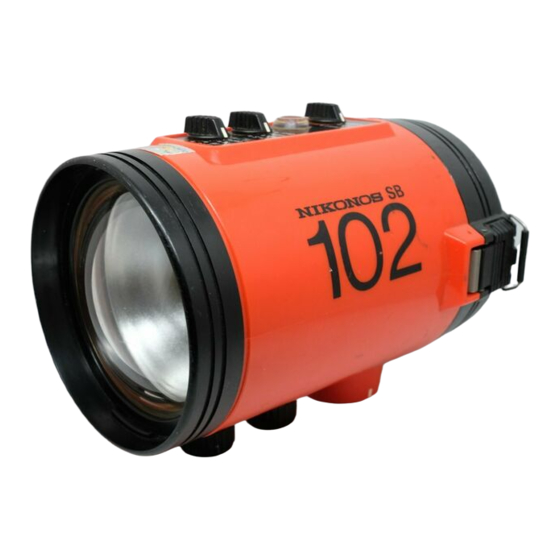Nikon SB-102 os Instruction Manual - Page 30
Browse online or download pdf Instruction Manual for Camera Accessories Nikon SB-102 os. Nikon SB-102 os 36 pages. Speedlight

CONTROLS IN DETAIL-continued
_ _ _ _
Replacing the Target-light
If
the target-light burns out, replace
it
with a new one
(provided) by performing the following procedures:
1. Remove
the
battery
chamber cap (see
page
8).
2.
Remove
the C-type
battery
cartridge.
3.
Turn
the target-light
holder
@
counterclockwise ap-
proximately
45
°.
4.
Pull up on the holder.
5.
Remove the old lamp
and
replace
it with a new one
.
6.
Replace
the
holder
and turn it clockwise 45°
.
7. Replace
the C-type
battery
cartridge.
8.
Replace
the battery chamber cap.
o
The
target·light can also be replaced by an authorized Nikon dealer or
service
center
if
you
desire.
58 ·102 or 58-101
(master
unit)
When two
or
more
flash units
are
the
same
distance
from the
subject
and face
approximately the same
direction, the combined GN of
the
units
can
be deter-
mined with the
following equation:
Combined GN
=
V
GN l'
+
GN2 2
+
GN3 2
+
.
Where
GN
1.
2. 3
are
the guide
numbers
of
the
flash units
o
Because
the
slave
flash unit
is
triggered when the light from the master
flash unit
reaches
it directfy or
is
reflected to
it
by the
subject, if
the
light
from
the
master flash unit
does not reach the
slave
flash unit or if
there
are
strong light sources nearby, the
slave
flash unit will not fire.
For best results, test· fire the
entire
multiple flash
system
by test
firing
the
master
flash
unit before
shooting.
o
During slave
flash
photography,
avoid other persons using
speedlights
or the
bursts
from
their
flash units will trigger your slave unit.
o
The
slave flash unit may be triggered by the light from
a
fluorescent
lamp.
30
Multiple Flash Photography
The
S8-102 has wireless slave flash
capability, enabling
it to be triggered by the light fired from
another
flash
unit.
For multiple
flash operation as
shown in
the
diagram,
use either an S8-102 or
S8
-101 as
the master flash unit
(the speedlight connected to the
camera).
Set
the T-S
switch
of
the slave flash
unit
(the speedlight
not
con-
nected to the camera)
to
"
SLAVE
"
or "T
&S."
After
confirming
that
the
flash
units
'
ready-lights are
lighted,
release the
shutter
to fire the master
flash
unit.
At
the
same
time,
the
slave unit will be
triggered
by
the
light
fired
from the master flash unit.
o
There
is
no
limit
to the number
of SB·102 Speedlights that can be
used
as slave
flash units at
one
time.
oFor multiple flash
operation,
all flash units must be
in
the manual
mode.
In
the TTL and non· TTL automatic
shooting modes,
the
correct
exposure cannot be obtained because the light from each speedlight
alters the
exposure
measurement.
Daylight Fill-In Flash Photography
When
shooting in
daylight,
a
backlit subject
may
come
out almost
as
a
si
lhouette
if the background is
correctly
exposed.
If,
on the other hand, exposure
compensation
is
made
to correctly
expose the s.ubject,
the
back-
ground may be washed out.
To
fill in the
shadows and
balance the illumination
levels
of the subject and
the
background
in
daylight
shooting
,
use daylight fill-in
flash
photography.
When
using the
Nikonos-V,
its viewfinder LED
indicator
will blink to
indicate
the
correct
shutter speed
under
natural
lighting
.
To
obtain the correct exposure with
daylight
fill
-in
flash
shooting
,
turn on the flash unit
and
select
progressively
smaller
f/stops (numerically
larger
f-numbers) until the camera
's
1/125
second
and 1/60
second LEDs
begin blinking or until eith.er
the
1/60
second or the
1/30
second
LED
indicator blinks. Make
sure
the
subject
is within
the coupling distance
range
and,
if
the viewfinder
ready-light
is
lighted,
release the
shutter.
Operable shutter
speed (1/90sec.)
Adjust the aperture until one
or
two
of these LED indicators
begins blinking
.
